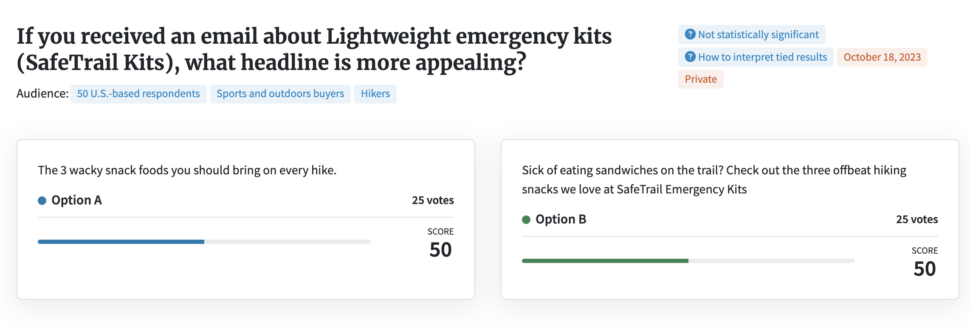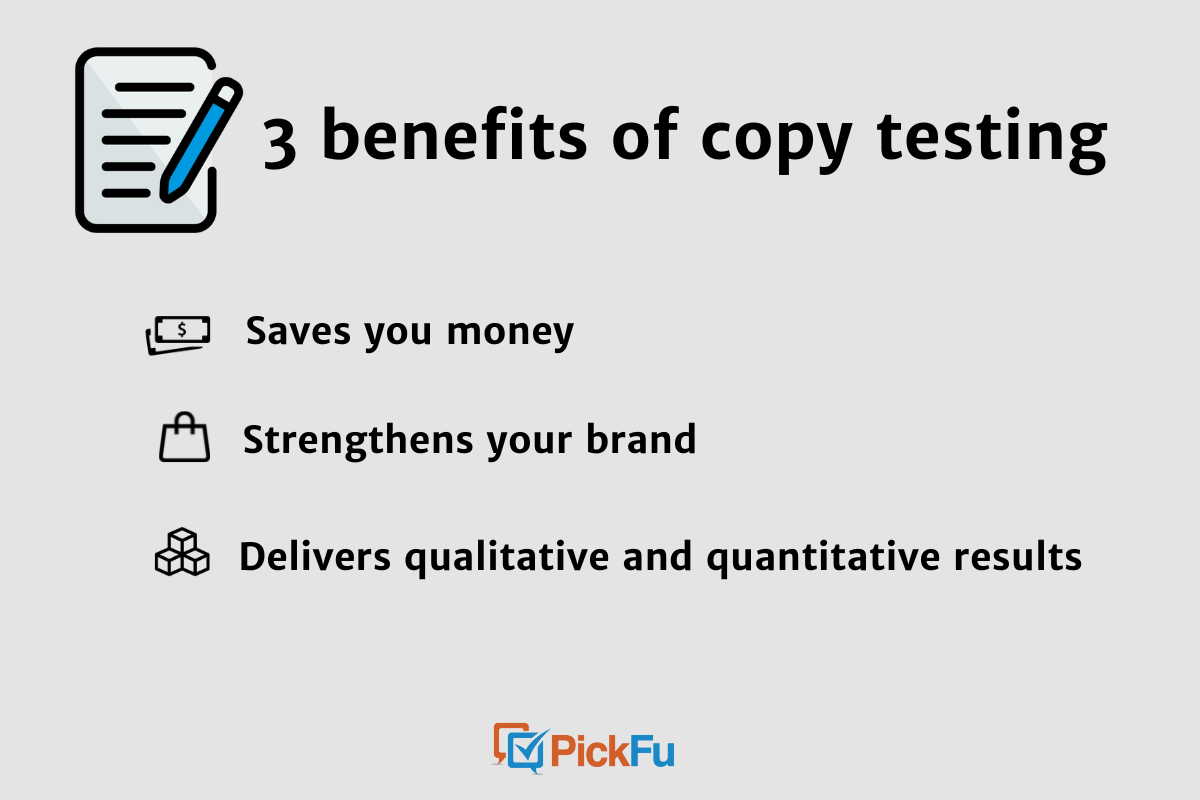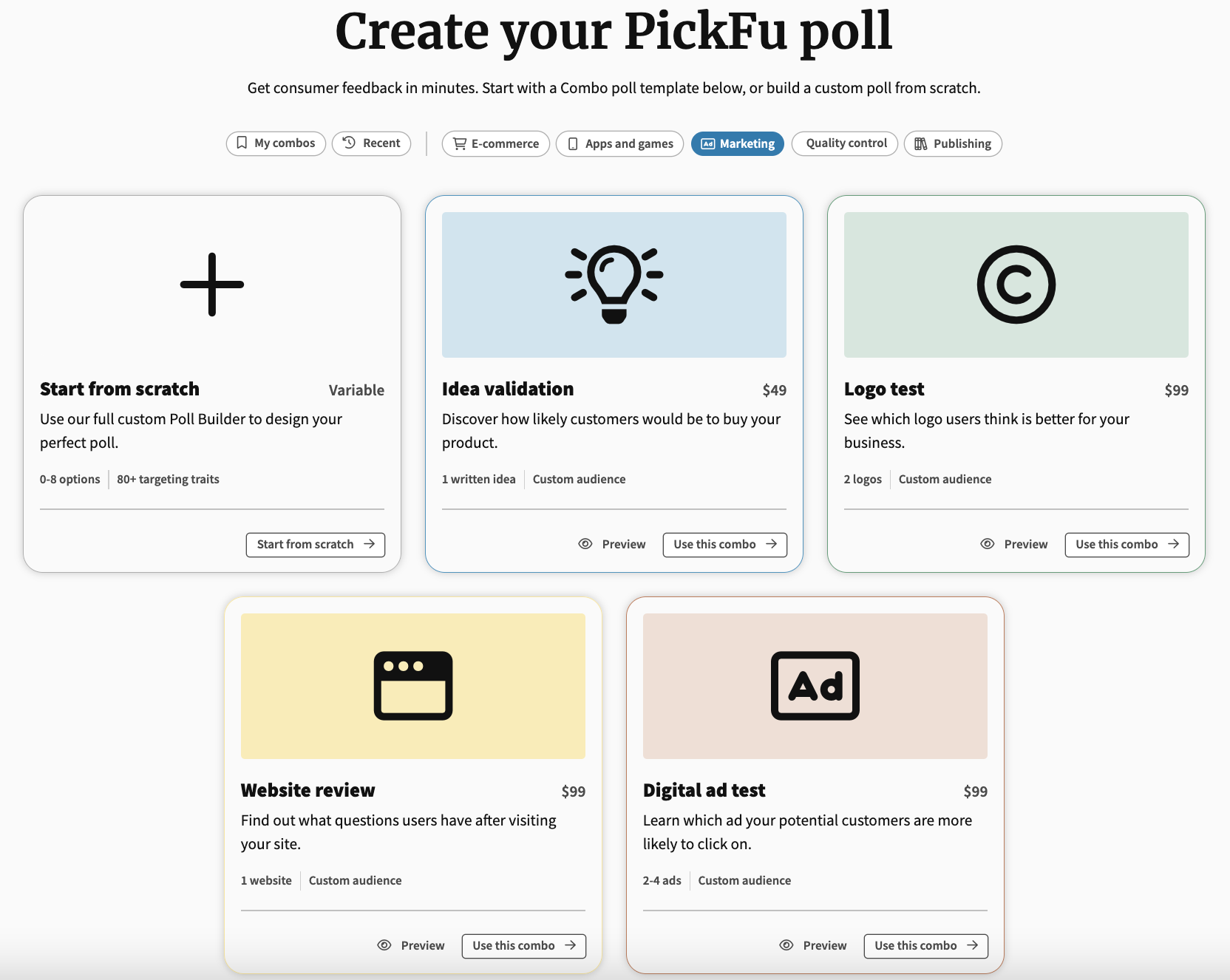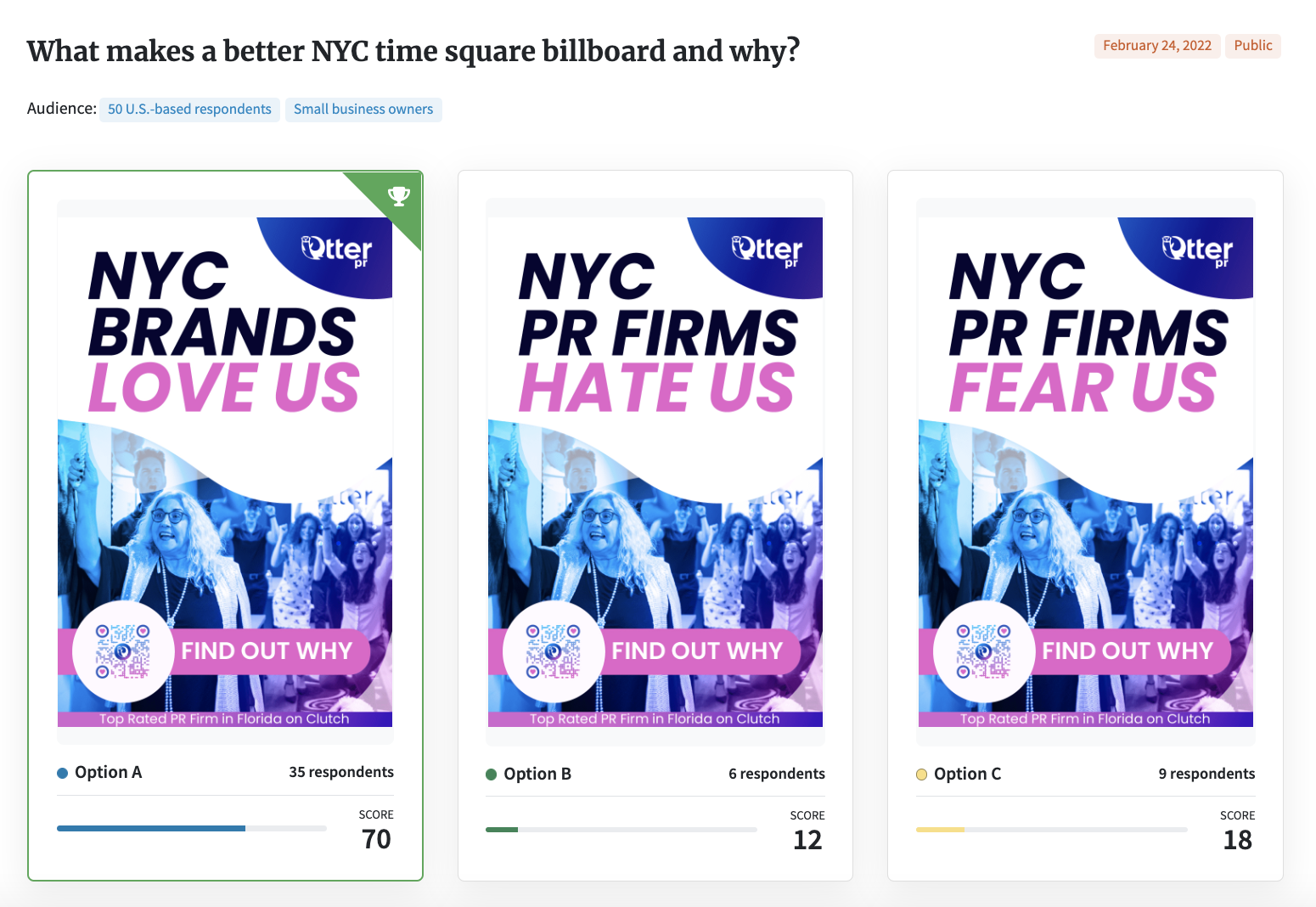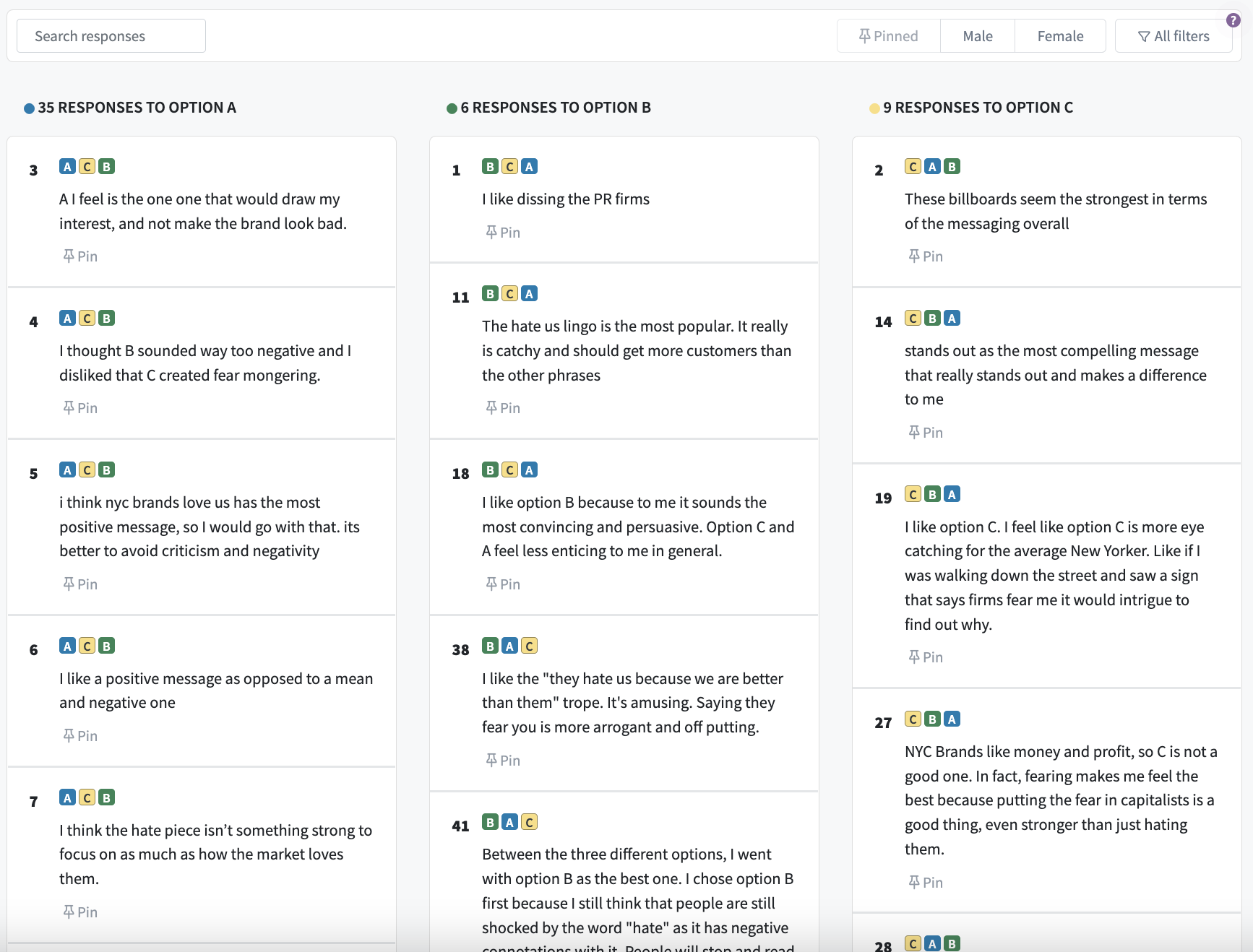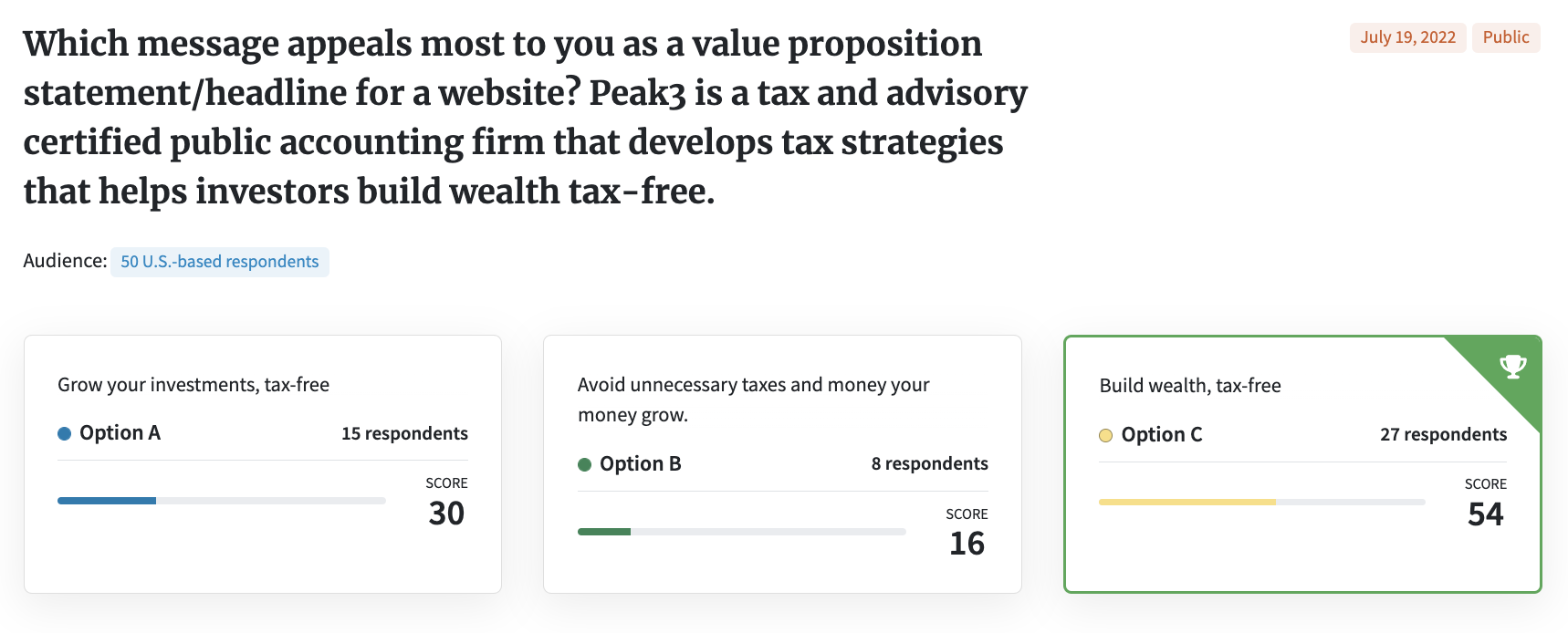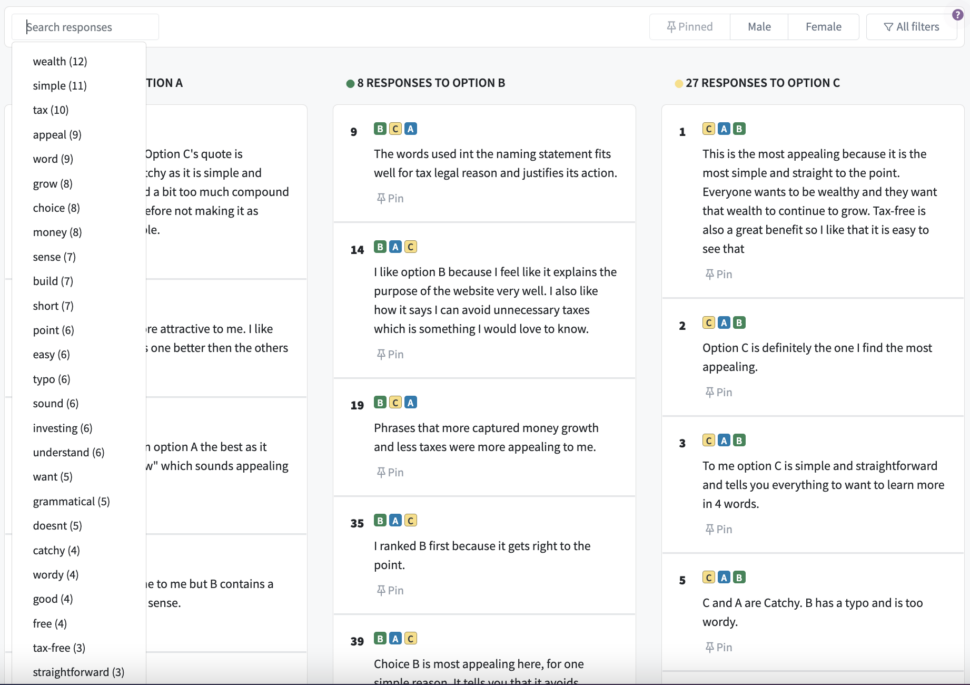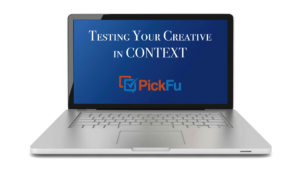If there’s one step you should take before spending money on PPC ads, landing pages, or other marketing assets, it’s copy testing.
Also known as pre-testing, copy testing is a type of consumer market research that tests your advertising copy with a target audience and analyzes their response.
This helps predict how well — or poorly — your copy will engage your audience.
Copy testing allows you to improve your marketing copy before it goes live, making it more impactful.
Today we’ll talk about tips and tools for effective copy testing. First, let’s look at the benefits of copy testing with your target market.
Follow along with these links:
Survey insight: Images are more powerful with the right copy
To understand the influence that ad copy has on consumers, we did some quick market research. We ran 50-person poll targeted to a group of hikers.
We asked this group of hikers which email newsletter heading they would click on for a product called SafeTrail Kits—a lightweight emergency kit for outdoor enthusiasts.
The two options?
- Option A: “The 3 wacky snack foods you should bring on every hike.”
- Option B: “Sick of eating sandwiches? Check out the three offbeat hiking snacks we love at SafeTrail Emergency Kits.”
Option A is short, snappy, and authoritative. Option B is longer and more conversational.
We thought shorter always meant better when it came to email newsletters, so we were surprised to find that 25 hikers chose Option A and 25 chose Option B.
In other words?
We got a statistically insignificant headline testing poll.
So we dove into the feedback.
The respondents who picked Option A had this to say about their choice:
- “This one is more attention-grabbing. I want to know what the 3 wacky snacks are.”
- “While [Option B] is more informative, I know I skip over emails with a long subject. I am choosing Option A just because it’s shorter.”
- “Option A is shorter and more to the point, it also engages curiosity better.”
These hikers found the short title easier to digest. While they thought Option B was good too, they didn’t want to read a long subject line. Plus, they were intrigued by the idea of wacky snacks.
Not so for the 25 hikers who chose Option B. Here’s what they said about the copy:
- “I think [Option A] is too boring. Option B sounds more appealing with the rhetorical questions and emphasizes emergency kits, which is an important feature.”
- “I like the recognition that trail foods are often the same thing. It makes me think about it and want different ideas which is why Option B is my top choice. I also prefer offbeat to wacky. Wacky makes me think there’s something really odd about the options, while offbeat just makes me think it’s a bit different.”
- “I kind of like the lead-in question ‘sick of eating sandwiches…’ It grabbed my attention more than the 3 wacky snack foods headline.”
These respondents favored Option B because it seemed more relevant to hiking, used a more appropriate word to describe the snacks—”offbeat” instead of “wacky”—and provided more information.
One thing that united this group of hikers? Their aversion to the phrase “wacky snacks.” Out of 25 respondents, 10 stated that they did not like the idea of a wacky snack.
And here’s what the statistical insignificance shows us: if SafeTrail Emergency Kits was a real company that actually sent Option A to its customers, 50% of them might be completely turned off by it.
Yikes!
That’s why testing the copy before it goes live is key. Whether you’re a team of FBA sellers or a startup or an established business, understanding your audience is crucial. So is using copy that sounds trustworthy, informative, and fun.
But not wacky.
Why is copy testing important?
Words are critical to the success of your ads, landing pages, product descriptions, and other marketing assets. Copy testing is important because it helps ensure that those words appeal to the people reading them.
Obviously, design is crucial too. But other research suggests that copy is more important than design.
Unbounce, which specializes in building landing pages, analyzed more than 36,000 pages, using a machine-learning model to predict conversion rates.
It found that across 16 industries, copy had twice the impact on landing page conversions as design.
Aside from helping you craft copy that converts, what are the benefits of copy testing? Let’s take a look.
The benefits of copy testing
💰 Copy testing saves you money
Testing your logo, ad, website, and other marketing copy before you put it out there can save you thousands of dollars. That’s because it gives you the chance to optimize the content. In other words, optimization helps you make sure the copy is interesting and relevant to your audience before it goes out into the world.
Marketing spend accounts for 9.5% of a company’s revenue on average. This varies between industries and size and type of business, with restaurants at the lower end (about 2%) and B2C at the higher end (12%), according to the U.S. Small Business Administration.
If your restaurant earns about $300,000 in annual revenue and you spend 2% of that on marketing, that’s $6,000 a year creating epic website copy, ads, and emails.
If you’re a retail business, you’ll spend even more on marketing — typically 3-8% of your revenue. So if your business’s monthly revenue is $80,000, you could spend anywhere from $2,400 to $6,400 a month on marketing.
Put simply, you can’t afford to use copy in your marketing that doesn’t resonate with your audience.
💯 Copy testing strengthens your brand
In today’s digital world, people are choosy about what they pay attention to.
You can’t just stick an ad on the internet and hope it’ll attract customers. You have to test your copy with your target audience first.
By message testing with your target customers, you’re able to see where you can improve your copy.
Getting in-depth feedback will help ensure that your ads, product descriptions, and landing pages are on brand and relevant to your customers. This builds trust, which ultimately strengthens your brand.
📚 Copy testing delivers qualitative and quantitative results
Traditional A/B testing puts different versions of an ad or landing page in front of a real-time audience of shoppers.
Over a period of weeks or even months, you’ll find out which version garnered more conversions. These quantitative results are helpful — there’s no doubt.
But they don’t give your audience a way to provide feedback, which is valuable qualitative data that can help you make meaningful changes right away. All you have to do is look at the SafeTrails Emergency Kits poll to see how helpful qualitative market research can be.
A/B testing also takes time and puts you at risk of losing sales if a variant isn’t popular.
This is increasingly important as Google and Amazon continually update their algorithms to keep pace with ever-evolving technology. Copy testing helps you prime your content for both Google and A9 optimization.
With copy testing, you ask your target audience which version of an ad they like best and give them the opportunity to provide feedback. This returns both qualitative and quantitative data.
When you copy-test with a platform like PickFu, you get feedback that same day, often within minutes. Plus, our AI tools for testing will summarize the feedback for you, making it easy to digest.
Test your ad copy on PickFu. Sign up for free.
Tips for effective copy testing
Now that you know why copy testing is important, let’s talk about how to get the most out of this critical component of digital marketing.
It comes down to three things: who you ask, what you ask, and what you do with the feedback.
Tip #1: Ask the right audience
Before you launched your business, you (hopefully) did your research to identify your customer needs and find out who is most likely to buy your product.
Once you’re ready for copy testing, audience segmentation — grouping your visitors, followers, and high-converting customers by demographics — is key to your testing success.
If you launched a line of children’s books about different countries, for example, you may have pinpointed parents with young to school-aged kids as your target audience.
The first year after launch can give you important insights into who is actually buying your products.
For our hypothetical kids’ book company, you might find over time that many of your social media followers are elementary school teachers.
Use data from surveys, Google Analytics, Facebook insights, your website stats, and engagement with your social media followers to narrow down the demographic groups that make up your target audience.
Maybe you’ll discover that Google shopping brings you the most customers, instead of Amazon Prime shoppers like you thought.
When it’s time to test your copy, put it in front of these groups. Don’t test book titles for your kids’ books with single entrepreneurs in their 20s. They aren’t going to care like your highest-converting customers will.
Tip #2: Ask the right questions
Traditional ad and landing page pre-testing measures two things:
- Recall: How much information from an ad sticks in the mind of the person who views it
- Persuasion: How likely the person is to purchase the product or service offered
How can you get answers to these questions? It’s all in the way you ask.
You can borrow elements from the day-after recall strategy. It involves taking a four-part approach to ad copy testing to gain meaningful metrics.
- Pre-exposure: Put your branding, logo, and brief company description in front of your audience segments and ask for their impression of what the brand does.
- Ad/copy exposure: Show your audience the copy you’re testing, either in a cluttered display — surrounded by other ads, as it would appear in real-time media channels — or isolation display, which gives viewers more time to absorb the format and text of the ad.
- Post-exposure: Ask your audience a series of questions to assess ad impact. Was this ad memorable? What message did it share with you? What did you like about it? What did you dislike? Would you click it?
- Profiling: Ask audience members where else they shop, whether they shop more online or in stores, and how often they shop to get a fuller picture of who your consumer jury is.
Most copy testing methods use one or more of the steps above.
Often, Steps 2 and 3 happen at the same time. You show your focus group an ad and ask for their feedback.
Some market research firms or services may let you ask profiling questions, while others won’t.
You can also ask questions by first asking yourself this question: what do you want to learn about the effectiveness of an advertisement from this group of people?
Create questions that lead to the answers you need and you’ll be on your way to collecting meaningful test results.
Tip #3: Take time to analyze the feedback
You can hire an advertising agency or use online tools to test ad campaigns all day, but if you don’t take the time to understand and apply the feedback, you miss out on the most important step of all.
Copy testing is all about getting feedback. You have to analyze the feedback to make all that testing worth it.
Sit down by yourself or with your team and comb through each vote and comment.
Look for patterns. For example, if several people mention that your PPC ad for handmade soaps makes them think they’re buying cookies instead, you’ve got a problem.
But because you tested your copy before publishing it in real time, you can fix the components of copy that don’t resonate with viewers.
This crucial step of analysis and application helps you create better copy.
Copy testing methods and tools
There are several methods for copy testing.
🗣 In-person focus groups allow you to see reactions from a small group of people in real time. The downside? Focus groups are costly and time-consuming.
📝 Simple surveys on Twitter, LinkedIn, or Facebook are another method. Keep in mind that your audience on social media platforms are likely to be biased and may not give their unfiltered opinion.
🖱 Your Google or Facebook ads managers give you important information about who’s clicking your ads. But they won’t tell you why.
🖥 Google Surveys alternatives such as Remesh or Qualtrics let you test video, print, and digital ads with segments of your target audience and use AI to interpret the feedback. You’ll pay a pretty penny to use such software tools.
✅ Another more budget-friendly option, PickFu, enables you to do enterprise-level research without any training or subscription required.
How to use PickFu for copy testing
PickFu makes it easy to pre-test not only ad copy, but also landing pages, product descriptions, book titles, article headlines, book blurbs, templates, label designs, and email subject lines. Any type of copy, in other words.
Once you sign in to PickFu, here’s how to set up a copy test:
- Click Start from scratch to create a new poll
- Choose a poll type: Head-to-head, Ranked, Open-ended, or Click Test
- Select your target audience: Choose from 90+ audience traits
- Upload your copy options, images, or other assets
Once you launch your poll, results start coming within minutes. Respondents submit written feedback with every poll. Even if a poll doesn’t technically achieve statistical significance—because of a tie or close race, for instance—you get that valuable consumer feedback to analyze.
In this PickFu poll testing a billboard ad, the user asked 50 small-business owners to rank three designs in order of preference.
The majority of respondents picked Option A — the only image with positive-sentiment copy — and explained why.
One respondent summed it up this way: “I selected [Option] A because it is a positive message, while the other options are negative. [Option] C is negative, however it is less abrasive and more to the point of showcasing potential competence. [Option] B is gimmicky, negative, and trite.”
Here’s another copy testing example. In this poll, the user asks 50 respondents to compare three value prop statements that would appear on an accounting firm’s website.
27 of the 50 respondents preferred Option C, the shortest of the three statements:
Using filters to search the responses by commonly used words, it’s clear that respondents found a “simple” and “short” message to be most effective.
Put copy testing to work for your brand
Copy testing will save you time, money, and disappointment.
To do it effectively, remember these 3 tips:
- Ask the right questions
- Ask the right audience
- Analyze the feedback
Then, use the feedback to polish your ads and marketing campaigns.
You’ll connect with your audience in meaningful ways, build trust in your brand, and ultimately, improve conversions.
Test your marketing copy using PickFu. Start today.


